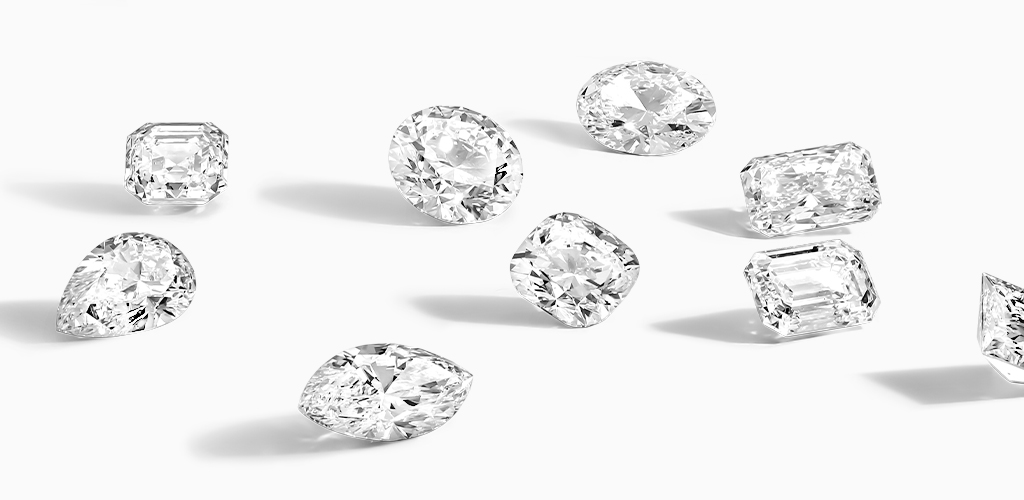
Lab-grown diamonds are becoming a growing trend for diamond shoppers. Here’s everything you need to know about their price, brilliance, creation processes, and more.
Lab-grown diamonds are optically and chemically the same as natural diamonds. The only difference is their origin and value. While natural diamonds are gemstones that grew beneath the earth’s surface, lab-grown diamonds are gemstones created here above ground.
Every lab-grown diamond starts as a diamond seed which is placed in a reactor or press. Then, carbon is added to help the seed grow into a full lab-created diamond.
The crystalline form of carbon we call “diamond” has historically only been attained through intense heat, constant pressure, and a good amount of time. Nowadays, we can achieve diamond growing conditions in specialized machines that knock a billion years off the cooking time. The result is a lab-grown diamond that differs from a mined diamond in name, rarity and value.
Lab-grown diamonds can be made using two different methods. The first is known as the HPHT method, where a small diamond seed is placed into a piece of carbon. The carbon is pressurized and exposed to high temperatures. Finally, the pressure and heat then melt the carbon, allowing a lab-grown diamond to form around the initial seed.
The second is the CVD method, which also requires a diamond seed. The seed is placed into a sealed chamber that is heated and filled with carbon-rich gasses. These gasses are ionized into plasma using advanced technology that breaks down the gas molecules and allows pure carbon to stick to the seed, forming a new lab-grown diamond.
Fun fact: It typically takes a lab-grown diamond less than a month to grow. A 1-carat white lab-made diamond takes around two weeks to form, whereas fancy color manufactured diamonds like yellow and blue lab-created diamonds take between 5-10 days to form.
Natural diamonds and lab-grown diamonds are both made from pure carbon, but they differ in rarity and value.
If you want to get technical, here’s what you need to know. Lab-grown diamonds have the same optical and chemical properties as their mined counterparts. The only significant difference is their origin and some microscopic evidence of its fast-growth. One comes from a natural and uncontrolled environment, while the other is physically created in a controlled laboratory.
Lab-Grown Diamonds
Natural Diamonds
You can’t tell the difference between lab-grown diamonds and natural diamonds without specialized equipment, even if you’re a professional gemologist. The best way to tell the difference between lab-grown diamonds and natural diamonds is to look at the grading report or with advanced instruments measuring the spectrometry.
Suppose a professional gemologist tries to determine if a diamond is mined or lab-grown; they would use magnification to look at the nature of the inclusions and overall diamond growth pattern. The inclusions and growth patterns in a natural diamond appear slightly different than in a lab-grown diamond.
Sometimes differences appear in how the diamond reflects light compared with a synthetic diamond.
In general, when looking at a lab-grown diamond next to a natural diamond, you can’t distinguish between the two.
Lab-grown diamonds offer numerous benefits for fans of this gemstone type, including:
Fun fact: Lab-grown diamonds are grown through unique processes. The CVD manufacturing method uses chemical vapor deposition (CVD), which makes it easier to keep up with demand without sacrificing the diamond’s quality while remaining a consciously sourced choice.
Traditional diamonds are the most expensive choice. The process of discovering, mining, and shipping natural diamonds is resource-intensive; the high cost of bringing them to market has helped diamonds achieve their luxe reputation.
A lab-grown diamond is perfect for when you want brilliance but want to pay less. Because the process of creating a lab-made diamond takes significantly less time and different resources than mining a diamond from the earth, lab-made diamonds cost significantly less than earth mined diamonds.
Because lab-grown diamonds can be produced at scale, they are less expensive and make larger carat diamonds more affordable. Their relative availability may not ensure that they will maintain value over time.
Like all our natural diamonds, our lab-grown diamonds also come with their very own birth certificate (IGI or GIA diamond grading report).
Since lab-grown diamonds are optically and chemically the same as mined diamonds, they come with their own grading report. Today, most lab-created diamonds are graded by IGI, International Gemological Institute.
Additionally, these lab-made diamonds are being accepted and graded by the GIA, the Gemological Institute of America, which has developed sophisticated devices that are used to screen and identify the difference between natural diamonds and lab-grown ones.

When choosing a stone for your diamond engagement ring, you need to consider your lifestyle, budget, and more.
Fans of budget-friendly shopping often prefer the lower prices of lab-grown diamonds, while people who prioritize rarity prefer earth made diamonds.
At the end of the day, it’s a personal choice. You can rest assured that any loose natural diamond or lab-created diamond you buy or set inside your engagement ring or wedding ring can be comfortably passed down from generation to generation.
Choosing the stone that suits your lifestyle is an important part of designing meaningful jewelry that will last you throughout your life. And if you choose to buy either lab-grown diamonds or natural diamonds, you can choose from 1000’s of beautiful options at James Allen.